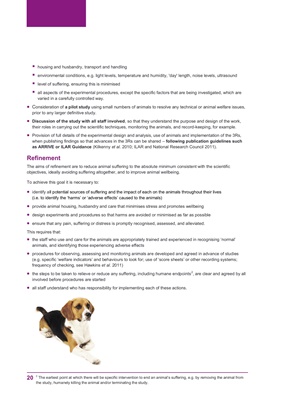
20
housing and husbandry, transport and handling
environmental conditions, e.g. light levels, temperature and humidity, 'day' length, noise levels, ultrasound
level of suffering, ensuring this is minimised
all aspects of the experimental procedures, except the specific factors that are being investigated, which are
varied in a carefully controlled way.
Consideration of a pilot study using small numbers of animals to resolve any technical or animal welfare issues,
prior to any larger definitive study.
Discussion of the study with all staff involved, so that they understand the purpose and design of the work,
their roles in carrying out the scientific techniques, monitoring the animals, and record-keeping, for example.
Provision of full details of the experimental design and analysis, use of animals and implementation of the 3Rs,
when publishing findings so that advances in the 3Rs can be shared - following publication guidelines such
as ARRIVE or ILAR Guidance (Kilkenny et al. 2010; ILAR and National Research Council 2011).
Refinement
The aims of refinement are to reduce animal suffering to the absolute minimum consistent with the scientific
objectives, ideally avoiding suffering altogether, and to improve animal wellbeing.
To achieve this goal it is necessary to:
identify all potential sources of suffering and the impact of each on the animals throughout their lives
(i.e. to identify the "harms" or "adverse effects" caused to the animals)
provide animal housing, husbandry and care that minimises stress and promotes wellbeing
design experiments and procedures so that harms are avoided or minimised as far as possible
ensure that any pain, suffering or distress is promptly recognised, assessed, and alleviated.
This requires that:
the staff who use and care for the animals are appropriately trained and experienced in recognising "normal"
animals, and identifying those experiencing adverse effects
procedures for observing, assessing and monitoring animals are developed and agreed in advance of studies
(e.g. specific "welfare indicators" and behaviours to look for; use of "score sheets" or other recording systems;
frequency of checking, see Hawkins et al. 2011)
the steps to be taken to relieve or reduce any suffering, including humane endpoints2
, are clear and agreed by all
involved before procedures are started
all staff understand who has responsibility for implementing each of these actions.
2 The earliest point at which there will be specific intervention to end an animal"s suffering, e.g. by removing the animal from
the study, humanely killing the animal and/or terminating the study.